When consumers think of deforestation, which commodity first comes to mind? If you guessed palm oil, you’re likely to be right.
The most consumed vegetable oil in the world is a major contributor to deforestation, thought to have contributed to 2.3% globally. ‘No palm oil’ claims on food and beverage products and lively orangutan imagery have helped to cement the association amongst shoppers.
However, the rate of deforestation associated with palm oil production is declining. Last year, WWF identified a slowing trend for deforestation linked to palm oil in Indonesia and Malaysia. Big names Nestlé, Unilever, Mondelēz International, amongst others, are well on their way to stamping out deforestation from their palm oil supply chains.
How has palm oil managed to reduce its environmental impacts that have long contributed to climate change and biodiversity loss? And what learnings can other commodities, such as coffee, cocoa, beef, and timber, take from the sector?
Engaging stakeholders to ‘build critical mass’
“The palm oil sector has to acknowledge that it’s doing a lot better than other sectors,” said Chris Wiggs, programme director at Dutch non-profit Aidenvironment during a recent webinar hosted by the Innovation Forum.
This makes for a ‘complicated’ issue: to combat deforestation, all sectors need to get up to at least the standard of palm oil.
Amongst the strategies that have worked for palm oil – and which could be leveraged to ensure all commodity sectors are on an ‘even playing field’ – is stakeholder engagement.
“One of the things we’ve learnt from our work at Proforest is that to really change things on the ground, you need critical mass and engagement of companies at all stages of the supply chain,” Proforest co-founder and director Ruth Nussbau told delegates at the event.
Much of the progress made in palm oil over the years can be directly linked to third party certification bodies, such as the Roundtable on Sustainable Palm Oil (RSPO), and their corporate members, she suggested. “And more recently, with things like the Palm Oil Collaboration Group (POCG). That coming together and building of critical mass is really important.”
Nussbau continued: “To make changes on the ground, we need to involve actors directly. What we’ve seen, is that we can accelerate by learning between commodities.”
Matthew Leggett, associate director, sustainable commodities and private sector engagement, at the Wildlife Conservation Society (WCS), agrees. ‘Bringing in’ and ‘engaging’ stakeholders, including environmental NGOs and local communities, is key, he suggested.
“I think there is still certainly work to be done [here], particularly in engagement of indigenous peoples. And not just in the palm oil sector, but in other commodity sectors globally.”
Indeed, a recent UN report highlighted how indigenous people can be the most effective forest protectors, with research in South America indicating deforestation rates in the Bolivian, Brazilian, and Colombian Amazon, where local communities were patrolling the land, were down compared to other areas.
Transparency and traceability in palm ‘shows what’s possible’
The need to take a ‘broader’ approach, beyond simply palm oil to conserve biodiversity, is ‘becoming gospel’, according to WCS’s Leggett. “Part of that broader approach can be learned from the palm oil progress that’s been made so far.”
Technological developments in palm oil deforestation monitoring, for example, have advanced apace in recent years.
Nestlé uses the Starling system, which leverages optical and radar satellites to monitor deforestation in its supply chain. The food giant has also helped fund a publicly available radar-based forest monitoring system known as Radar Alerts for Detecting Deforestation (RADD).
Unilever also uses satellite technology in its palm oil supply chain as well as geolocation data via a pilot with US tech company Orbital Insight.
“The work that has been done in the palm oil sector around traceability and transparency is incredible,” said Leggett. “It shows what’s possible, and shows what can be achieved in very complex supply chains…”
Given the high standard of data tools now available, the WSC associate director suggested some level of ‘prioritisation’ be employed. “We know where deforestation is happening. We have the best possible data tools that have ever existed to tell us where deforestation, forest loss and conversion is happening.”
A common issue facing the sector is that deforestation often occurs outside of major concessions, on land managed by smallholders. These farms often produce multiple commodities for global supply chains.
“I think we need to urgently start thinking about prioritisation. There is a need to ‘triage’ the way we approach some of these problems. We need to make the best use of traceability and transparency data and tools…that focus on forest and farm frontier areas.”
Leggett continued: “In other commodity supply chains, particularly timber and coffee, that work has begun. And I would like to see it accelerated.”
Warning against a ‘cookie cutter’ approach
Not all are convinced that what has worked in palm oil will also work in other commodities, however.
Attempting to employ the same strategies, according to Mark Wong, head of downstream sustainability at the world’s largest producer of certified palm oil, Sime Darby Plantation, seems like a ‘matter of convenience more than anything else’.
This is because ‘palm oil companies are more engaged’, he told delegates. “So you reach for the tool box, you pull out the same tool, expecting that you’re going to get the same result.
“But I think we’re in a situation now where we understand the issues better…and what is really needed is that we need to engage more actors and more stakeholders who are a lot more plugged into those critical issues.”
Some learnings, such as satellite monitoring and issue detection tools, can be shared across different commodities. As can some engagement approaches. In fact, there is potential for lots to be shared, we were told.
But Wong warned against taking a ‘cookie cutter’ approach from palm oil to other commodities. “We develop set tools – whether that’s traceability, satellite monitoring, or the way we conduct assessments – and expect that we can just ‘cookie cutter’ them across all the different landscapes to address the issues.”
The sustainability expert continued: “We need to try and shy away from that…because each landscape is different. There is a different set of stakeholders, there is a different set of drivers, so we really need to try and drive that conversation on the ground in those areas so that we are able to develop a situation that is most effective and required in that landscape.”
Time, as always, is of the essence, Wong suggested: “The sooner we start, the sooner we…are going to put something effective on the ground.”




